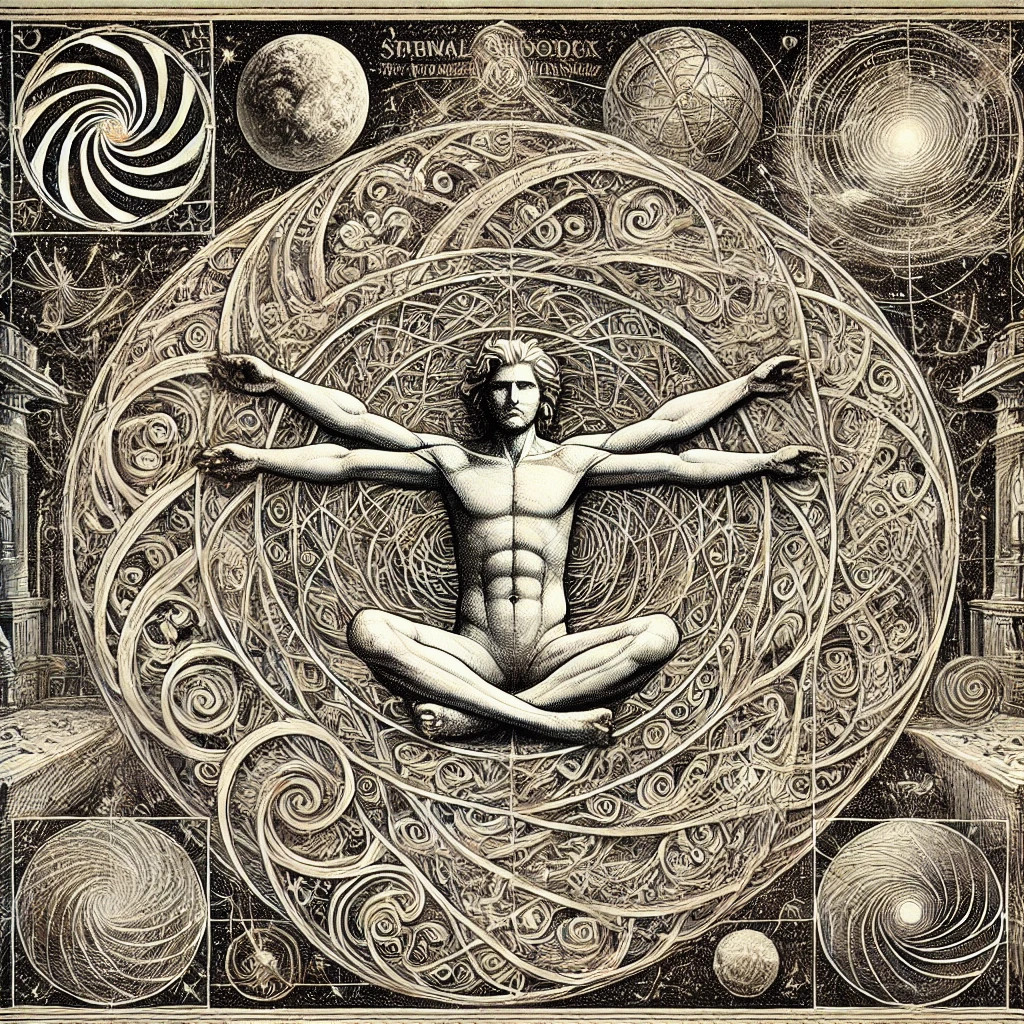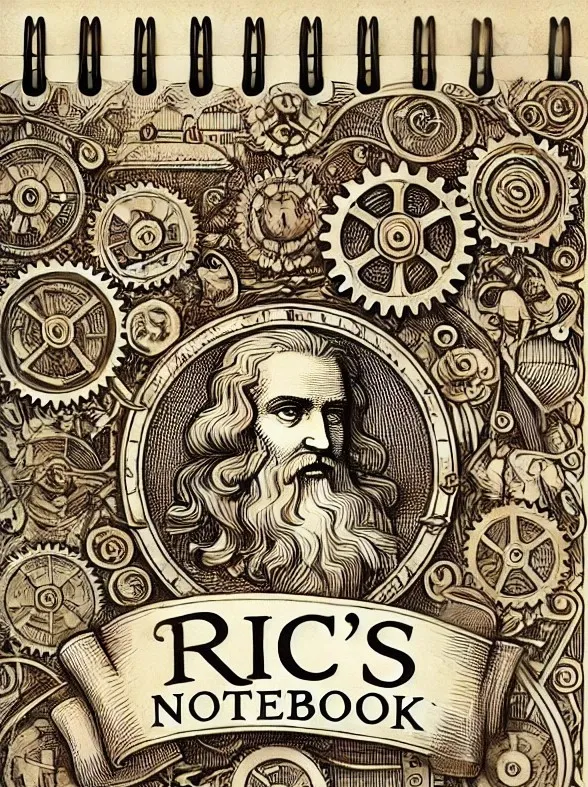
- Published on
- Authors

- Name
- ric de yuga 😄
🕰️ Introduction: A Temporal Odyssey
Welcome, intrepid explorers of the temporal realm! Prepare to have your perception of time and space challenged as we embark on a captivating journey through the frontiers of reality. In this article, we will delve into the intriguing idea that our perception of time is inextricably linked to our motion through the cosmos, and explore the tantalizing possibility of accessing the past through astral projection. Along the way, we will examine the scientific foundations of relativity and the mind-bending concept of closed timelike curves. So, buckle up and get ready for a thought-provoking expedition through the labyrinthine corridors of time and space!
🌌 The Fabric of Spacetime: A Relativistic Tapestry
🎨 Painting Time as a Dimension
In the realm of special relativity, time is no longer a mere spectator but takes center stage as a fully-fledged dimension, interwoven with the three spatial dimensions to form the magnificent tapestry of spacetime. This four-dimensional manifold, where the position of an object is described by three spatial coordinates (x, y, z) and one time coordinate (t), forms the backdrop against which the cosmic dance of reality unfolds.
🕰️ The Relativity of Time: A Temporal Tango
In this relativistic waltz, the passage of time becomes a fluid and malleable entity, its rhythm dictated by the motion of the observer. The faster one moves through space, the slower time marches on, a phenomenon known as time dilation. This curious effect is encapsulated in the spacetime interval (ds) between two events, given by the equation:
ds² = -c²dt² + dx² + dy² + dz²
where c is the speed of light, dt is the time difference, and dx, dy, and dz are the spatial differences between the events. This equation serves as a cosmic metronome, governing the intricate interplay between space and time.
👥 The Twin Paradox: A Relativistic Reunion
To illustrate the mind-bending nature of time dilation, let us embark on a thought experiment known as the "twin paradox." Imagine a pair of identical twins, one content to remain on Earth while the other embarks on a high-speed cosmic journey. As the adventurous twin rockets through space at velocities approaching the speed of light, time begins to slow down for them relative to their Earth-bound sibling. Upon their return, the traveling twin emerges youthful and invigorated, having experienced less time than their aged counterpart. This paradoxical reunion serves as a testament to the malleable nature of time in the face of relative motion.
🌀 Astral Projection: A Spiritual Odyssey
🔮 Transcending the Physical Realm
While the concept of astral projection, or the notion of an out-of-body experience, lies beyond the bounds of current scientific understanding, it has long captivated the human imagination. This esoteric idea suggests that one's consciousness can temporarily detach from the physical body and explore the astral plane, a realm beyond the confines of ordinary space and time.
🕳️ Accessing the Past: A Temporal Portal?
Some proponents of astral projection argue that this transcendent state may offer a gateway to accessing the past, allowing individuals to traverse the corridors of time and witness events that have long since transpired. While this concept remains firmly in the realm of speculation and is not supported by scientific evidence, it raises intriguing questions about the nature of consciousness and its relationship to the fabric of reality.
🌈 The Scientific Frontier: Exploring the Boundaries of Reality
🎭 General Relativity: A Cosmic Stage
In the grand theater of general relativity, gravity takes on a starring role as the curvature of spacetime itself. This revolutionary theory, proposed by Albert Einstein, paints a picture of the universe as a malleable fabric, where massive objects like stars and planets leave their mark by warping and distorting the cosmic stage upon which they reside.
🔄 Closed Timelike Curves: A Temporal Loop
Within the mathematical framework of general relativity, there exist peculiar solutions to Einstein's field equations known as closed timelike curves (CTCs). These enigmatic paths through spacetime, if traversed, would allow an object to interact with its own past, creating a mind-bending temporal loop. However, the existence of CTCs remains highly speculative and raises a host of paradoxes and logical inconsistencies that challenge our understanding of causality and the nature of time itself.
🌅 Conclusion: Embracing the Mystery
As we reflect upon the captivating ideas explored in this article, we find ourselves standing at the precipice of a vast and mysterious reality. The notion that our perception of time is intrinsically linked to our motion through space, as described by the elegant equations of special relativity, invites us to ponder the fluid and relative nature of temporal experience.
While the concept of astral projection and the idea of accessing the past through transcendent states of consciousness remain firmly in the realm of speculation, they serve as a testament to the enduring human fascination with the boundaries of reality and the nature of our existence.
As we continue to explore the frontiers of science, from the mind-bending implications of general relativity to the enigmatic notion of closed timelike curves, we are reminded of the vast and complex tapestry that is our universe. Each new discovery and theoretical insight serves as a brush stroke on the cosmic canvas, gradually revealing the intricate beauty and profound mysteries that lie at the heart of reality.
In the face of such awe-inspiring concepts, we are humbled and invigorated, driven to continue our quest for understanding, even as we embrace the inherent uncertainties and paradoxes that arise along the way. For it is in the pursuit of knowledge, in the willingness to question our assumptions and explore the boundaries of the possible, that we truly embark on the greatest adventure of all: the journey of the human mind as it seeks to unravel the secrets of the cosmos.
So let us continue to dream, to imagine, and to explore, forever pushing the boundaries of our understanding and marveling at the wonders that await us in the vast and mysterious realm of time and space.
🔢 Equations: A Mathematical Interlude
For those eager to delve deeper into the mathematical foundations of the concepts explored in this article, let us briefly venture into the realm of equations.
The spacetime interval (ds) between two events, as described in special relativity, is given by:
ds² = -c²dt² + dx² + dy² + dz²
where c is the speed of light, dt is the time difference, and dx, dy, and dz are the spatial differences between the events.
In the context of general relativity, Einstein's field equations describe the relationship between the curvature of spacetime and the presence of matter and energy:
Gᵢⱼ + Λgᵢⱼ = 8πG/c⁴ Tᵢⱼ
where Gᵢⱼ is the Einstein tensor, representing the curvature of spacetime, Λ is the cosmological constant, gᵢⱼ is the metric tensor, G is Newton's gravitational constant, c is the speed of light, and Tᵢⱼ is the stress-energy tensor, describing the distribution of matter and energy.
These equations serve as the mathematical backbone of our understanding of space, time, and gravity, providing a glimpse into the intricate tapestry of the universe.
When you visit these dimensions in dream like state you are not grounded and it is less efficent at manifesting compared to when you do it whille lucid living
https://www.instagram.com/reel/DCFKB1pyd0e/
📜 References
- Einstein, A. (1916). Die Grundlage der allgemeinen Relativitätstheorie. Annalen der Physik, 354(7), 769-822.
- Hawking, S. W., & Ellis, G. F. R. (1973). The Large Scale Structure of Space-Time. Cambridge University Press.
- Misner, C. W., Thorne, K. S., & Wheeler, J. A. (1973). Gravitation. W. H. Freeman and Company.
- Gödel, K. (1949). An Example of a New Type of Cosmological Solutions of Einstein's Field Equations of Gravitation. Reviews of Modern Physics, 21(3), 447-450.
- Tart, C. T. (1967). A second psychophysiological study of out-of-the-body experiences in a gifted subject. International Journal of Parapsychology, 9, 251-258.
